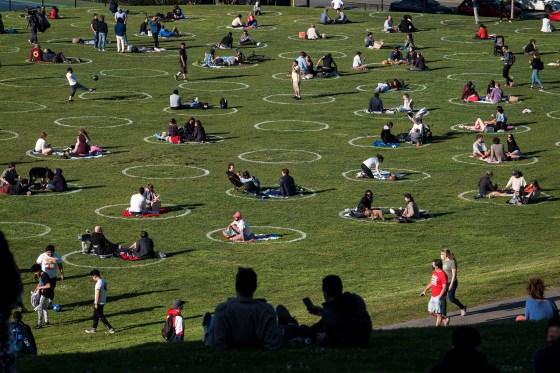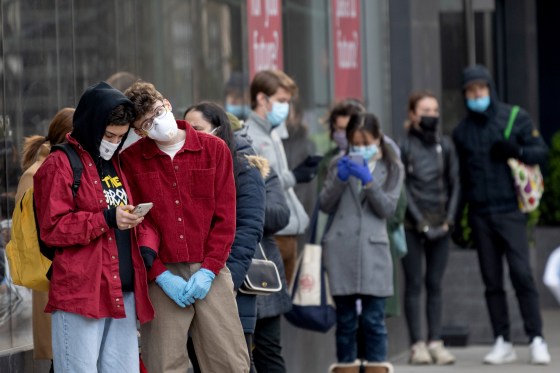New story in Health from Time: Interrogator, Therapist, Nurse: What it Takes to be a Coronavirus Contact Tracer
(SALT LAKE CITY) — Health investigator Mackenzie Bray smiles and chuckles as she chats by phone with a retired Utah man who just tested positive for the coronavirus.
She’s trying to keep the mood light because she needs to find out where he’s been and who he’s been around for the past seven days. She gently peppers him with questions, including where he and his wife stopped to buy flowers on a visit to a cemetery. She encourages him to go through his bank statement to see if it reminds him of any store visits he made.
Read more: Here’s How Quickly Coronavirus Is Spreading in Your State
Midway through the conversation, a possible break: His wife lets slip that they had family over for Mother’s Day, including a grandchild who couldn’t stop slobbering.
“Was there like a shared food platter or something like that?” Bray asks. “There was, OK, yep … sharing food or sharing drinks, even just being on the same table, it can spread that way.’”
Suddenly, with a shared punch bowl, the web has widened, and Bray has dozens more people to track down.
She is among an army of health professionals around the world filling one of the most important roles in the effort to guard against a resurgence of the coronavirus. The practice of so-called contact tracing requires a hybrid job of interrogator, therapist and nurse as they try coax nervous people to be honest. The goal: To create a road map of everywhere infected people have been and who they’ve been around.
While other countries have devised national approaches, a patchwork of efforts has emerged in the U.S. where states are left to create their own program.
Bray normally does this type of work to track contacts for people with sexually transmitted diseases. She is now one of 130 people at the Salt Lake County health department assigned to track coronavirus cases in the Salt Lake City area. The investigators, many of them nurses, each juggle 30 to 40 cases, and try to reach everyone the original person was within 6 feet (1.8 meters) of for 10 minutes or more. They stay in touch with some people throughout the 14-day incubation period, and calls can take 30 minutes or more as they meticulously go through a list of questions.

Some estimate as many as 300,000 contact tracers would be needed in the U.S. to adequately curtail the spread. While some states like Utah have reported having enough contact tracers, others are hundreds or even thousands of people short.
The contact tracers often find themselves in a tangled web of half-truths and facts that don’t match up. Language and cultural barriers arise that require interpreters and taxing conversations that leave the investigators wondering if the person understands what they’re trying to do.
They land on occasion into complicated family dynamics where people are reluctant to tell the truth.
Health investigator Maria DiCaro found out days into a case that a father was sleeping in his car because he and his wife were separating. The man had stopped returning DiCaro’s calls, and that key information came from his child.
“I get people that lie all time,” DiCaro said. “I try to get as much information from the beginning but it’s just not always the case. And time is one of those things you can’t take back when you are trying to prevent and you know do these contact tracing investigations.”
Each call is an exercise in good cop, bad cop. She needs people to cooperate, but no one is legally required to answer the questions. Usually kindness works better than strong words.
Some people lie because they’re scared, or they forget an outing. Construction workers, housekeepers and others without paid sick time may gloss over symptoms so they can get back to work. Some immigrants without documentation brush off testing because they fear it could lead to deportation.
“People sometimes think contact tracing is black and white but there is a lot of gray that goes into it,” said Bray, who often thinks about her parents and 97-year-old grandmother as she works to help stop the spread of the virus. “Our worst fear is that we push too hard and we lose someone. It’s not just their health on the line, it’s the people around them.”
Read more: The U.S. Has Flattened the Curve. Next Up Is ‘Squashing’ It — and That’s Not Going Well
No matter the tension, Bray and DiCaro give frequent reminders of why it all matters: “Thank you for what you’re doing. You’re helping the community,” DiCaro says during one call.
She knows that on the other end of the line, the first call from a tracer can be jarring. Sometimes, DiCaro and Bray have to break the news that someone was exposed or tested positive.
“It’s normal to talk to like your doctor, but you don’t ever expect the health department to call you and be like, ‘You were exposed to a serious disease,’” said Anissa Archuleta.
The 23-year-old got a call from DiCaro after she, her sister and her mother took a rare break from hunkering down to help organize a drive-by birthday party for a young cousin. They dropped off a present, then caved and accepted an impromptu invitation to go inside to grab some food.
What they didn’t know: the father of the birthday boy had the coronavirus, and unknowingly exposed more than a dozen people at the gathering.

After that first call, DiCaro checked in every day for two weeks. The fear slowly faded after their tests came back negative and they began building a rapport with DiCaro. She asked about their symptoms and how they were feeling each day and learned about how Archuleta’s mother lost her voice to fibromyalgia. Archuleta would pass along messages her mother whispered in her ear.
And after a while, Archuleta began asking DiCaro about her life and how she was holding up.
About a week in to their calls, on the daily check-in, Archuleta thanked DiCaro for caring about them and checking in every day. Tears welled up in DiCaro’s eyes. “Ah thanks,” she said as she grabbed a Kleenex to wipe her eyes.
After she hung up, she leaned back in her chair and closed her eyes for a few seconds.
“When you do this like 10-12 hours a day … It’s nice to get those positive reactions from people that are very grateful who do see the purpose of what we are doing,” said DiCaro. “It’s nice to be appreciated.”